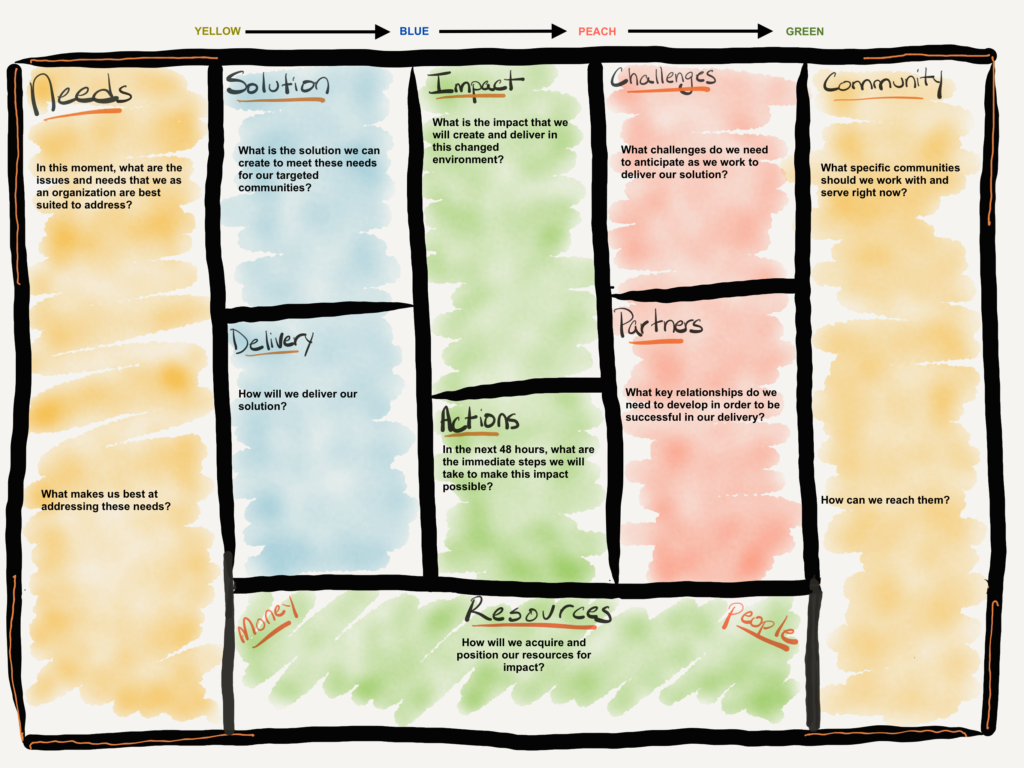The genesis of Creation in Common’s adaptive strategy map provides a great story about how the pandemic has affected those of us who work in and with the nonprofit sector. At its heart, the tale is about capturing the crucial learnings and capabilities that have emerged: adaptability, thinking on our feet, and taking an action-oriented approach, and how they can benefit us as we move forward. Perhaps most importantly — and surprisingly — the urgency within the pandemic showed that most organizations can actually make some really good decisions really quickly.
When the pandemic abruptly uprooted the daily workings of nonprofits across the country, there was one thing most organizations had in common: the need to quickly pivot and rethink the way they worked. The Creation in Common team felt moved to contribute to the national effort to guide nonprofits through the turbulence. We wanted to create a tool that could be implemented immediately, with little training, that would align with what organizations may already be doing.
Within a week of the shutdown in March, we had created the four-page Adaptive Strategy Map. Inspired by existing Lean and Agile tools, it was designed to help nonprofit teams corral and organize their efforts, capture and track their experiments and iterations in real time, and build a common vocabulary of change among colleagues. It could be used to track major pivots and well as multiple smaller ones.
As we walked our clients through the map, we came to a realization: most organizations weren’t so much innovating as remixing. They were experimenting with ways to fill immediate needs at a specific moment in time working with what they had.
Before the pandemic, many of us had a tendency to immediately identify barriers. We often didn’t give ourselves the freedom to make good, quick decisions with the information that we had. We hesitated to take small risks and see where they took us. The pandemic changed that.
If there are any major learnings from the pandemic and all of the related pivoting, it’s that this more agile, adaptive way of thinking isn’t necessarily about big bets. It’s more about very small, practical bets with a lot of utility behind them. One example is the way some food banks quickly pivoted from food choice models, delivered through pantries and food shelves, to setting up parking lots to serve food-insecure families as quickly as possible. That pivot allowed them to be very responsive.
We started asking how we could extend and build on those capabilities beyond the pandemic. An Agile-like iterative approach can be of great benefit, even when you aren’t in emergency mode. There are tenets in this adaptive strategy map that organizations still need.
This realization has affirmed the beginnings of a shift in our thinking about strategic planning implementation. Many people view strategic plans as to-do lists. But when strategic plan priorities are just another to-do list, they’ll always rank near the bottom in comparison to the tornado of day-to-day priorities. So how do organizations begin to make progress on larger goals and objectives?
The key is to focus on the cycle of learning and iteration that emerged during many pandemic experiments. Nonprofit teams can use the same strategies they used when pivoting. That includes being much more mindful about learning, adjusting, marking progress, learning again, and readjusting. Identifying and centering learning, particularly around strategic priorities, while tracking, observing, and discussing even minor progress helps strategies advance and gain momentum. Being able to track learning and progress in real time keeps organizations actively engaged in pursuing their goals and objectives.
We’re currently adapting the adaptive strategy map as a tool to help clients do just that. Rather than saying, “Oh, I didn’t finish the to-do list,” the map will help track iterations that mark progress towards goals, even when they’re just small bets. It will also help clients retain that sense of experimentation, iteration, learning, and advancement so they can make better decisions while implementing their strategic plans.
implementing strategic plans in a linear fashion, with a beginning, a middle, and an end, can cause teams to overlook the fact that actions within the strategies they’re pursuing are often very dynamic. Instead of thinking linearly, we encourage organizations to remain flexible and keep embracing experimentation. Pay attention to what you’re learning. Keep pivoting. And celebrate your progress. That’s the way to successfully implement your strategic plan.


